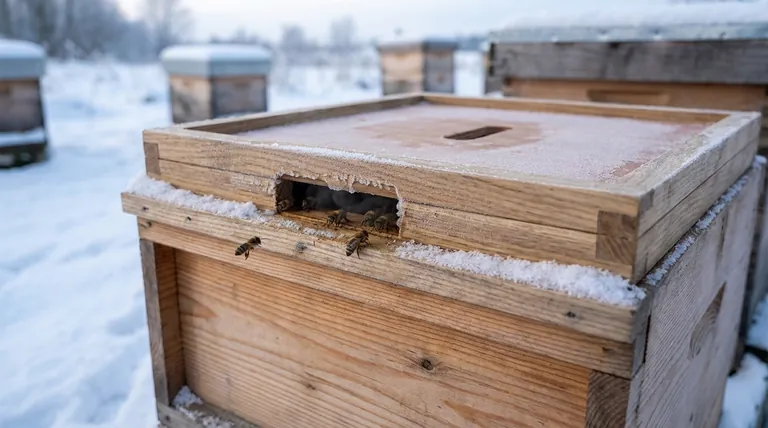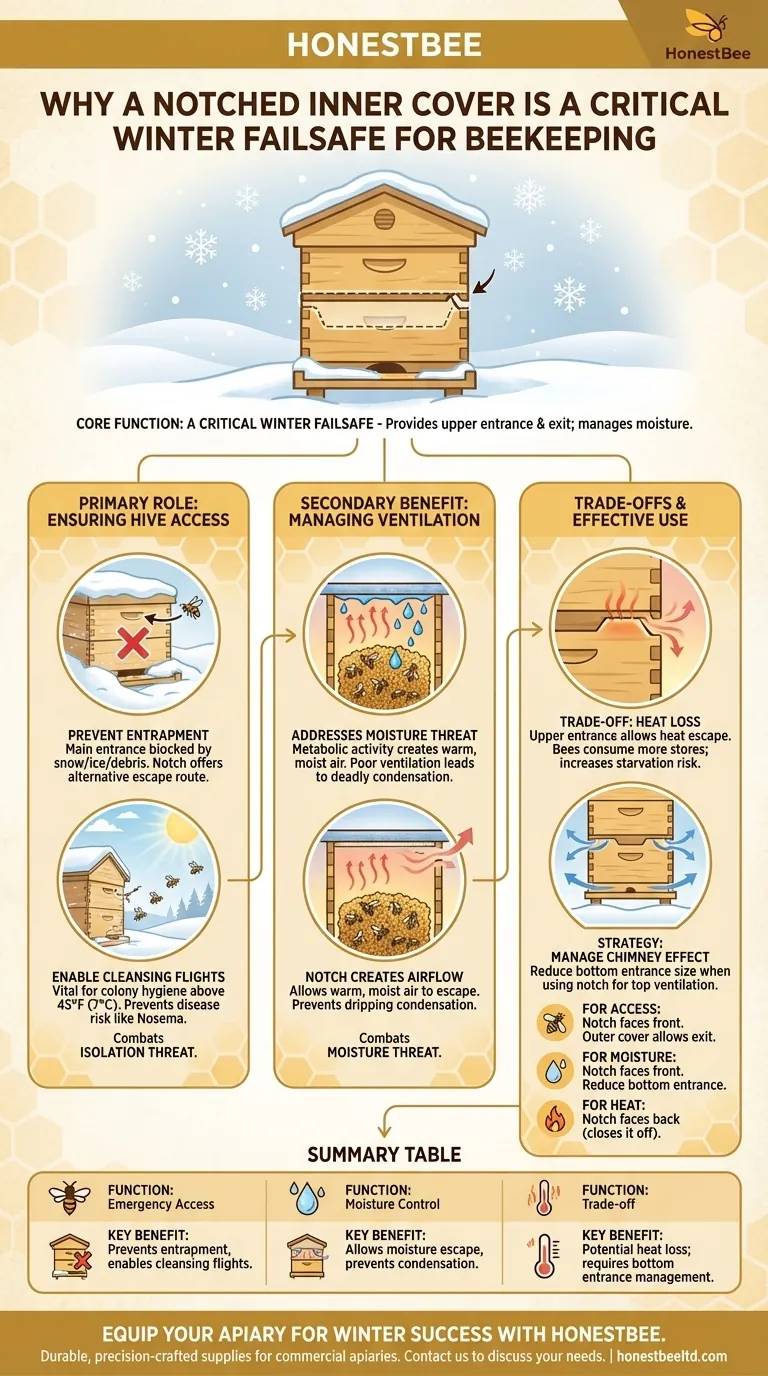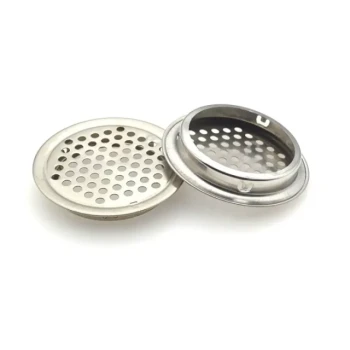At its core, a notched inner cover is a critical winter failsafe for a honeybee colony. Its primary purpose is to provide an upper entrance and exit path for the bees. This becomes essential if the main hive entrance at the bottom is blocked by heavy snow, ice, or even an accumulation of dead bees.
Winter survival for honeybees is a battle against two primary threats: moisture and isolation. A notched inner cover directly addresses the risk of isolation while also playing a critical secondary role in managing the more insidious threat of internal hive moisture.

The Primary Role: Ensuring Hive Access
A colony's ability to enter and exit the hive, even during the coldest months, is more important than many realize. The notched inner cover provides a simple, reliable solution.
Preventing Entrapment
During winter, the main entrance at the bottom of the hive is highly vulnerable. Heavy snowfall can drift up and completely seal it off.
Likewise, melting and refreezing cycles can create a solid barrier of ice, trapping the bees inside for extended periods. The upper notch provides an alternate route, ensuring the colony is never completely locked in.
Enabling Cleansing Flights
On warmer, sunny winter days (often above 40-45°F or 4-7°C), bees will briefly leave the hive on "cleansing flights" to defecate. This is a vital behavior for colony hygiene.
If bees are unable to take these flights because the entrance is blocked, they are forced to soil the inside of the hive. This drastically increases the risk of diseases, particularly Nosema, which can devastate a wintering colony.
The Secondary Benefit: Managing Ventilation
While hive access is the notch's direct purpose, its impact on ventilation is an equally important—and often overlooked—benefit for winter survival.
Why Moisture is a Greater Threat than Cold
Bees are exceptionally good at generating heat and surviving cold temperatures by forming a tight cluster. However, the byproduct of their metabolic activity is water vapor.
In a poorly ventilated hive, this warm, moist air rises, hits the cold inner cover or top, and condenses into water. This cold water can then drip back down onto the cluster, chilling and killing the bees far more effectively than cold air alone.
How the Notch Creates Airflow
The small opening provided by the notch allows this warm, moist air to escape the top of the hive. This creates a passive but constant airflow.
This "top ventilation" is crucial for carrying moisture out of the hive, keeping the interior dry and preventing the deadly condensation that can doom an otherwise healthy colony.
Understanding the Trade-offs
Using a notched inner cover is not without its considerations. It represents a balance between access, ventilation, and heat retention.
Potential for Heat Loss
The most significant trade-off is heat loss. An upper entrance, even a small one, allows some of the heat generated by the bee cluster to escape.
This means the bees must consume more of their winter honey stores to maintain the cluster's temperature, increasing the risk of starvation if food reserves are not ample.
The "Chimney Effect"
If both the lower entrance and the upper notch are left wide open, it can create a "chimney effect." This strong draft can pull too much cold air through the hive.
Many beekeepers mitigate this by significantly reducing the size of the bottom entrance when using a notched inner cover for top ventilation.
How to Use the Notch Effectively
Your strategy for using the inner cover notch should align with your specific winter management goals and local climate conditions.
- If your primary focus is emergency access: Place the inner cover with the notch facing the front of the hive. Ensure the outer cover is positioned to allow the bees to exit from the notch.
- If your primary focus is moisture control: Use the notch as an upper vent, but consider pairing it with a reduced lower entrance to prevent a strong draft.
- If your primary focus is maximum heat retention: In milder climates or if you use another ventilation method (like a quilt box), you might choose to position the inner cover with the notch facing the back, effectively closing it off.
Properly managed, this simple feature is a powerful tool for ensuring your colony emerges from winter healthy and strong.
Summary Table:
| Function | Key Benefit |
|---|---|
| Emergency Access | Prevents colony entrapment from snow/ice and enables vital cleansing flights. |
| Moisture Control | Allows warm, moist air to escape, preventing deadly condensation inside the hive. |
| Trade-off | Can lead to some heat loss, requiring careful management of the lower entrance. |
Ensure your apiary is equipped for winter success. HONESTBEE supplies durable, precision-crafted beekeeping supplies and equipment, including inner covers, to commercial apiaries and beekeeping equipment distributors. Our wholesale-focused operations ensure you get the reliable gear you need to protect your colonies. Contact HONESTBEE today to discuss your winter equipment needs and keep your hives thriving.
Visual Guide

Related Products
- Inner Beehive Cover for Beekeeping Bee Hive Inner Cover
- Professional Insulated Winter Hive Wrap for Beekeeping
- Stainless Steel Round Beehive Air Vents for Ventilation
- HONESTBEE Professional Long Handled Hive Tool with Precision Cutting Blade
- Professional Drop-Style Hive Handles for Beekeeping
People Also Ask
- What is the function of the center hole in the inner cover? Master Hive Ventilation and Feeding
- Why might beekeepers use an inner cover under the telescoping outer cover? Simplify Hive Management & Protect Your Colony
- What is the role of inner covers in insulated beehives? Master Moisture Control for a Healthy Colony
- What is an inner cover in a beehive and what are its features? A Key Tool for Hive Health & Management
- What is the role of the inner cover in a beehive? Essential Climate Control for Hive Health



















